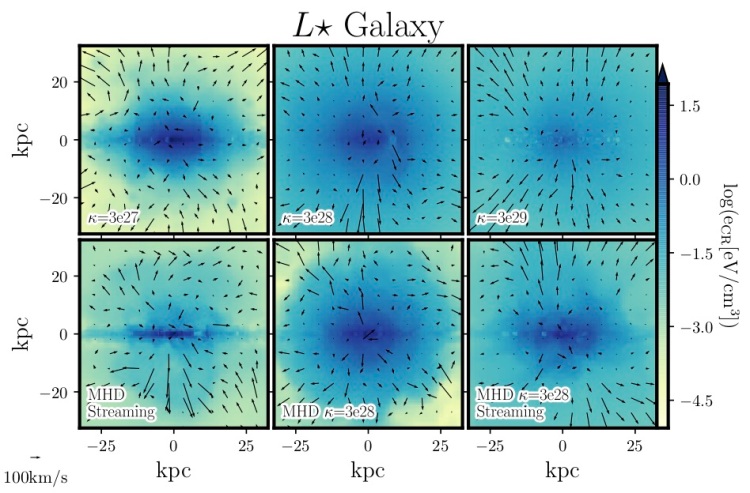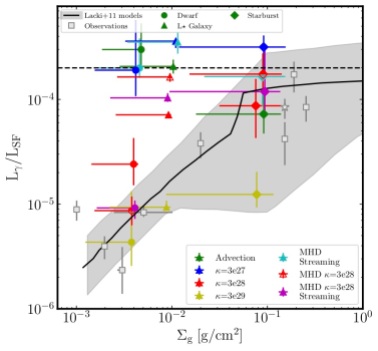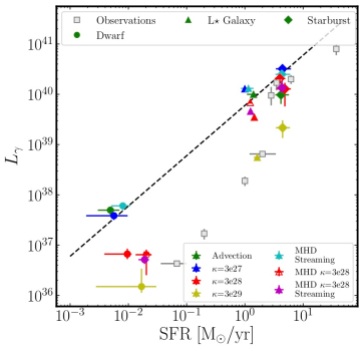Cosmic rays (CRs) are energetic charged particles originating outside the Earth. They could have strong effects on galaxy evolution, which we are going to study with galaxy simulations.
We have successfully implemented CRs and CR feedback in GIZMO:
(The first paper is published in MNRAS and available on arXiv: http://arxiv.org/abs/1812.10496 ;
Subsequent papers on
)
- Numerical implementation:
- CRs as a two fluid models (gas+CRs);
- Injection: 10% of supernova energy;
- Loss: Coulomb and hadronic losses;
- Transport: CR diffusion and streaming with the efficient two-moment method (similar to Jiang+Oh 2018), which enables High Resolution galaxy simulations with Fast CR propagation!
- A Wide Range of Simulated Galaxies:
Idealized galaxy simulations: dwarf, sub L star starburst, and L star galaxies;
- A Variety of CR propagation models:
(a) Advection; (b) Isotropic Diffusion; (c) Anisotropic Diffusion; and/or (d) Streaming;
Results:
(1) CR distributions strongly depend on propagation models:

(2) CRs can suppress star formation in dwarf and L star galaxies:
(3) The “effective isotropized” CR diffusion coefficients ~ 3e28-29 cm^2/s are consistent with the observed γ ray emission (the dashed line shows the CR proton calorimetry, i.e. most of the CRs dissipate within the galaxies)
(4) Most of the CRs can escape from dwarf and L star galaxies when matching the observed γ ray luminosity, but not starburst galaxies.
(5) Ongoing: dramatic differences between CR and thermal driven winds:
Cooler & Slower


Movie Time:
Here are some cool movies featuring cosmic ray feedback on different galaxies!
Images are weighted by mass times temperature, so higher temperature gas (>10^3K) is more visible.
The movie below shows idealized dwarf galaxies with (left) and without cosmic rays (right) (with isotropic diffusion coefficient 3e28cm^2/s). Surprisingly, cosmic rays allow more cold gas (magenta) to stay within the disks.
MW-mass galaxies with (left) and without cosmic rays (right). There is significant fast outflowing hot gas on the left but warm slow outflowing gas on the right at late times:
Starburst galaxies with (right) and without (left) cosmic ray (diffusion coefficient=3e28cm^2/s):
Additional materials:
I have given a talk in the 2018 Santa Cruz galaxy workshop:
The slide is available here: TsangKeungChan_CRdrivenwind
I have also worked on simulating pionic gamma ray emission from cosmic rays, which can be seen in the poster ( Poster_CR_A0) I presented in the 15th Potsdam Thinkshop.






